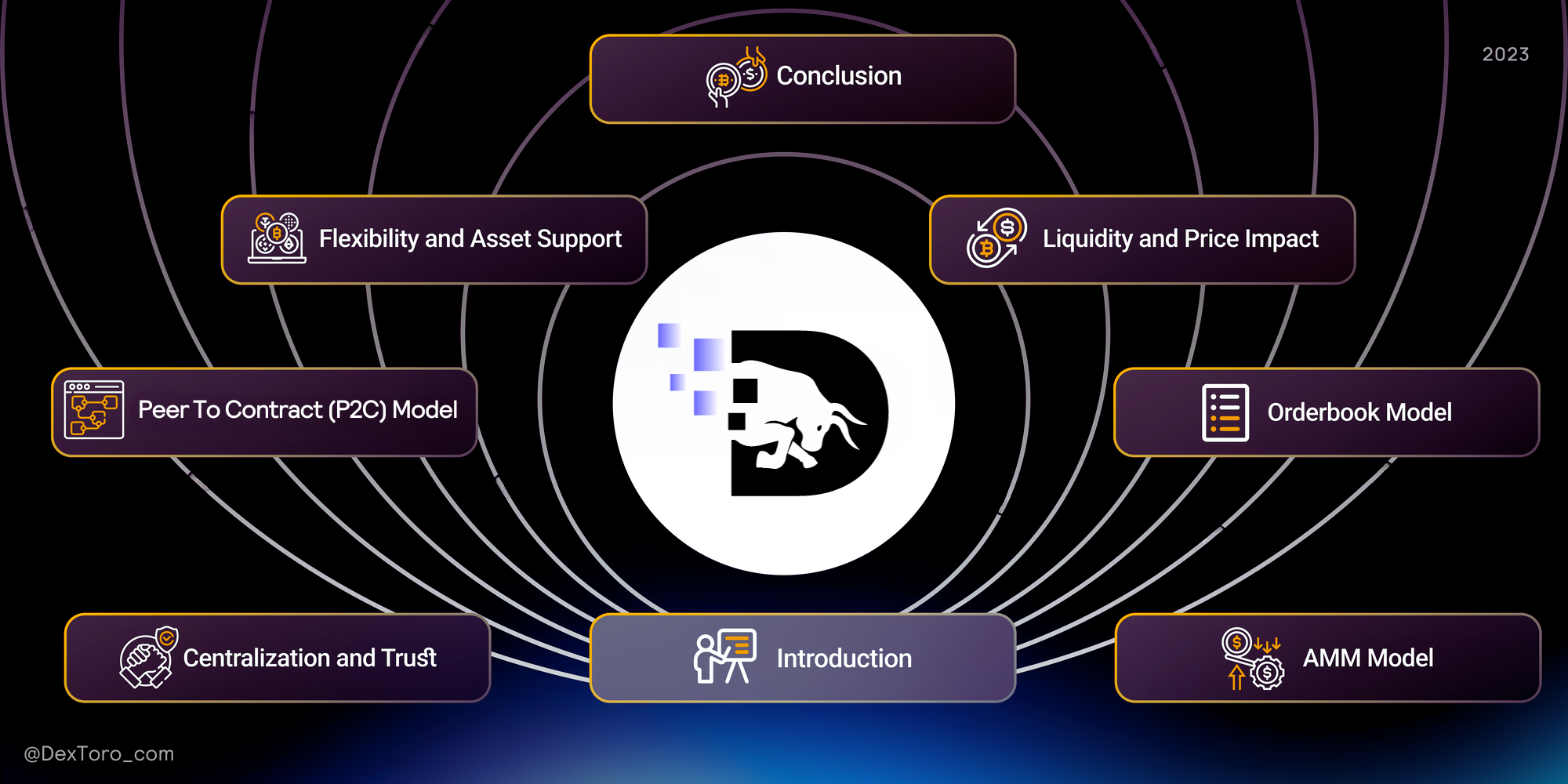AMM vs. Order Book vs. Peer-to-Contract (P2C): Contrasting Trading Models for Trading
In the complex world of cryptocurrency trading, two primary trading models stand prominent - traditional Order Book Exchanges and the newer Automated Market Makers (AMMs).

In the complex world of cryptocurrency trading, two primary trading models stand prominent - traditional Order Book Exchanges and the newer Automated Market Makers (AMMs). However, there is a third trading model, which is underappreciated and superior in all aspects, known as the Peer-to-Contract (P2C). These models, while sharing a common goal of facilitating trade, follow entirely different paths to achieve it. Understanding these differences is crucial for everyone, from those who have just set foot in the world of cryptocurrencies to the most seasoned traders.
Let's take a closer look at these three models, breaking down how they work, their benefits, and potential pitfalls.
Understanding AMMs
Automated Market Makers (AMMs) represent a new wave in the field of cryptocurrency trading. Unlike order book exchanges, AMMs use a different model to facilitate trades. Rather than relying on buyers and sellers to make and take offers, AMMs use mathematical algorithms and smart contracts to automatically set the price of a token based on its supply and demand.
In an AMM, anyone can become a liquidity provider by depositing tokens into a liquidity pool. These pools are then used to execute trades, with the trading price determined by the ratio of the tokens in the pool. This system is fully automated, eliminating the need for an order book.
While AMMs have their advantages, such as enabling permissionless trading and offering potential earnings for liquidity providers, they also have their drawbacks. One of the most significant is 'impermanent loss,' a temporary loss that liquidity providers can face if the price of their deposited tokens fluctuates.
Two well-known examples of AMMs are Uniswap and SushiSwap. Each platform showcases its own approach to AMM-based trading, shaping the current state of decentralized cryptocurrency trading.
Understanding Order Books
At its core, an Order Book Exchange is a traditional model that uses a list to organize buy and sell orders for a specific cryptocurrency. These orders are sorted by price level, and they represent the live market demand for a cryptocurrency. The order book records these transactions in real-time, providing a detailed insight into the market activity around a particular cryptocurrency.
The order book typically consists of three parts:
- buy orders;
- sell orders;
- the order history.
Buy orders record all the bids, showing the amount that buyers are willing to purchase. Sell orders, on the other hand, include all the asking prices that people are willing to sell. The order history documents all the transactions that have occurred.
The key strength of Order Book Exchanges lies in their transparency and control. Traders can see at a glance the level of market interest in a cryptocurrency, and they have the ability to set their own prices for buy or sell orders. This level of insight and control is appealing to many traders, especially those involved in high-volume trading.
Many centralized exchanges (CEX), like Binance, operate with an order book, offering a wide range of cryptocurrencies and high volumes.
Disadvantages of The Order Book Model
- Order books aren't efficient and can be negative for illiquid markets as it is hard to find matching orders at a fast pace, due to the large spread of bid and ask orders and low trading volumes.
- Market manipulation is an issue when using an order book model.
Understanding Peer-to-Contract
The Peer-to-Contract trading model is essentially traders taking trades against a smart contract that contains liquidity.
DexToro is a trading platform for synthetic assets. It allows users to trade between synthetic forms of fiat currencies, cryptocurrencies, and commodities, all without an orderbook or counterparty. Trading on DexToro is P2C (peer-to-contract), so there's infinite liquidity and no slippage.
P2P VS P2C
Peer-to-peer is one of the best-known formulas from the DeFi ecosystem. For a long time, it was a core idea behind decentralized trading.
Yet blockchain technology improvement and the creativity of developers brought new possibilities. P2C - peer-to-contract model puts smart contracts as a side of the transaction. Because smart contract can’t be influenced by any central authority after it was started, P2C doesn’t compromise decentralization.
Essentially, Automated Market Makers are peer-to-contract solutions because trades take place between users and a smart contract.
But specifically in DexToro's case, our peer-to-contract architecture removes all the negative aspects of the traditional AMM model, DexToro completely removes slippage from the equation.
Deep Dive: AMM vs. Order Book
Diving deeper into the mechanics of both trading models, we will explore four key aspects: liquidity and price impact, flexibility and asset support, user experience and complexity, and centralization. Each of these aspects influences a trader's experience and decisions. We'll unpack how Order Book Exchanges and AMMs differ in these areas, highlighting their unique features, benefits, and challenges.
Liquidity and Price Impact
AMMs bring continuous liquidity to the table. Their unique algorithmic approach ensures that trades can always be executed, no matter the token pair or trade size. However, they have an inherent drawback known as 'slippage.' Slippage refers to the difference between the expected price of a trade and the executed price, and it tends to increase as trade size goes up.
On the other hand, traditional Order Book Exchanges are well-known for their capacity to handle larger trades with lower slippage. However, during times of market turbulence or lower activity, these exchanges might encounter challenges in maintaining their liquidity levels, which could impact the immediate execution of trades.
While in these situations, traders in AMMs could withdraw liquidity to avoid losses; there is still a tradeoff. LPs in AMMs often face the challenge of impermanent loss due to their limited flexibility in how they provide liquidity, leaving them exposed to market risk.
Flexibility and Asset Support
AMMs are marked by their flexible asset support, welcoming an extensive array of tokens, even the newest ones entering the crypto market. This broad embrace makes AMMs a fertile ground for those keen on venturing into emerging opportunities.
On the other hand, order book exchanges follow a more cautious path. They enforce stricter listing criteria, favoring well-established, proven assets. While this approach might limit the variety of assets, it ensures robust liquidity for popular trading pairs, offering a degree of stability and predictability that many traders are looking for.
Remember, DexToro uses the Peer-to-Contract model, which means we have the best of both worlds explained above. We support a wide variety of assets without sacrificing liquidity on any of those assets, as they are all connected to the same smart contract with billions of TVL ready to utilize by our traders.
User Experience and Complexity
AMMs score high on user experience, offering a straightforward, intuitive interface that attracts beginners in the cryptocurrency world. With no complex charts or intricate order types, they make the trading process seamless.
Conversely, order book exchanges present a steeper learning curve. Detailed information and advanced trading features can be daunting for newcomers. However, experienced traders appreciate these complex tools for the comprehensive market insights and sophisticated trading strategies they enable.
Hence, while AMMs appeal to those seeking simplicity, order book exchanges cater to the needs of seasoned traders seeking depth and detail.
Centralization and Trust
AMMs are decentralized, removing the need for intermediaries and reducing custodial risks. In contrast, many of the traditional order book exchanges are centralized, handling users' funds and transactions, which can lead to concerns about trust and potential vulnerabilities.
Conclusion
As we've seen, both Order Book Exchanges, Automated Market Makers, and Peer-to-Contract models serve crucial roles in the world of cryptocurrency trading. Order Books, with their advanced functionalities and market depth, are preferred by seasoned traders, while AMMs, with their user-friendly interfaces and permissionless trading, have democratized access to the market, appealing especially to new entrants.
As the crypto space matures, fully decentralized derivatives exchanges like DexToro, are only getting faster and more powerful. At the moment, the only trade off we encounter compared to Centralized Exchanges is the speed and performance of executing trades. As blockchain technology matures, we expect DeFi to surpass the capabilities of CEX's.
About DexToro
DexToro’s mission is to democratize access to financial opportunity.
Join the discussion on Discord or follow us on Twitter.
Learn more at DexToro.com

